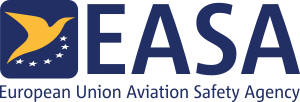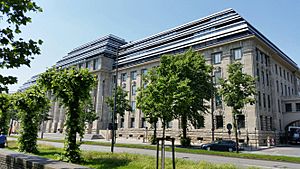European Union Aviation Safety Agency facts for kids
 |
|
 The offices of the agency in Cologne, Germany |
|
| Agency overview | |
|---|---|
| Formed | 12 July 2002 |
| Jurisdiction | EU and EFTA members |
| Headquarters | Cologne, Germany |
| Agency executive |
|
| Key document |
|
The European Union Aviation Safety Agency (EASA) is an important group in the European Union (EU). Its main job is to make sure that flying is safe for everyone. EASA works on rules, checks planes, and makes sure that airlines follow safety standards. It also collects information about safety and works with other groups around the world.
The idea for EASA started in 1996. The agency was officially created in 2002 and began its work in 2003.
Contents
History of EASA
EASA is located in Cologne, Germany. It was first called the "European Aviation Safety Agency" when it started on July 15, 2002. By 2008, it was fully working. It took over tasks from another group called the Joint Aviation Authorities. In 2018, its name changed to the "European Union Aviation Safety Agency." Countries that are part of the European Free Trade Association (EFTA) also work with EASA. The United Kingdom was a member until the end of 2020.
EASA has many jobs. These include:
- Looking into and studying safety information.
- Giving permission for foreign airlines to fly in Europe.
- Helping the European Commission write new safety rules.
- Checking that safety rules are followed, including doing inspections.
- Approving new types of aircraft and their parts.
- Approving companies that design, build, and fix planes.
EASA also helps with an effort called "Single European Sky II." This project aims to make air traffic control across the EU more organized. EASA was given more tasks for this project before 2013. Since December 4, 2012, EASA can approve large areas of airspace if more than three countries are involved.
In 2012, a group called the European Court of Auditors looked at EASA. They suggested that EASA should have its own clear rules about fairness. This would help make sure that all decisions are made fairly for everyone.
What EASA Does
EASA is in charge of approving new aircraft, engines, and parts for flying. This is called "type certification." EASA works with the national aviation groups in each EU country. It has taken over many of their jobs to make sure aviation rules are the same across the EU.
EASA also helps the European Commission make agreements with other countries about aviation safety. For example, it works with the US Federal Aviation Administration (FAA). EASA also sets rules for places that fix aircraft. These places are called "repair stations." EASA gives certificates to repair stations outside the EU so they can work on EU planes.
Since 2018, EASA's work has grown to include UAVs, which are also known as drones. The first rules for drones were put in place by December 30, 2019.
Yearly Safety Report
Every year, EASA publishes a report about aviation safety. This report includes facts and figures about flying safety in Europe and around the world. Some of this information comes from other groups like the International Civil Aviation Organization.
In June 2020, EASA stopped Pakistan International Airlines from flying to Europe. This happened after a plane crash in May. EASA took this action to make sure that safety standards were met.
Countries EASA Works With
EASA is not a group that countries join. Instead, all countries that are part of the European Union automatically work with EASA. They also follow EASA's safety rules. Countries cannot choose not to be part of this system.
Some European countries that are not in the EU, but are in the European Free Trade Association (EFTA), also work with EASA. These countries include Liechtenstein, Norway, Switzerland, and Iceland. They are part of EASA's management board but do not have voting rights. EASA has the same power in these countries as it does in EU member countries.
EASA also works with other aviation groups around the world. For example, EASA works with countries in the EU's Eastern Partnership. These countries include Armenia, Azerbaijan, Georgia, Moldova, and Ukraine. They work together to use EU aviation safety rules.
List of Current EASA Member-States
Here are some of the countries that work with EASA:
 Austro Control
Austro Control Belgian Civil Aviation Authority
Belgian Civil Aviation Authority Civil Aviation Administration (Bulgaria)
Civil Aviation Administration (Bulgaria) Croatian Civil Aviation Agency
Croatian Civil Aviation Agency Department of Civil Aviation (Cyprus)
Department of Civil Aviation (Cyprus) Civil Aviation Authority of the Czech Republic
Civil Aviation Authority of the Czech Republic Danish Civil Aviation and Railway Authority
Danish Civil Aviation and Railway Authority Estonian Civil Aviation Administration
Estonian Civil Aviation Administration Finnish Transport and Communications Agency
Finnish Transport and Communications Agency Directorate General for Civil Aviation (France)
Directorate General for Civil Aviation (France) Federal Aviation Office
Federal Aviation Office Hellenic Civil Aviation Authority
Hellenic Civil Aviation Authority National Transport Authority (Hungary)
National Transport Authority (Hungary) Icelandic Transport Authority
Icelandic Transport Authority Irish Aviation Authority
Irish Aviation Authority National Agency for Civil Aviation
National Agency for Civil Aviation Latvian Civil Aviation Agency
Latvian Civil Aviation Agency Office of Civil Aviation of Liechtenstein
Office of Civil Aviation of Liechtenstein Public Transport Competence Agency
Public Transport Competence Agency Directorate of Civil Aviation of Luxembourg
Directorate of Civil Aviation of Luxembourg Civil Aviation Directorate of Malta
Civil Aviation Directorate of Malta Human Environment and Transport Inspectorate
Human Environment and Transport Inspectorate Civil Aviation Authority of Norway
Civil Aviation Authority of Norway Civil Aviation Authority
Civil Aviation Authority National Authority of Civil Aviation of Portugal
National Authority of Civil Aviation of Portugal Romanian Civil Aeronautical Authority
Romanian Civil Aeronautical Authority Civil Aviation Authority of the Slovak Republic
Civil Aviation Authority of the Slovak Republic Civil Aviation Authority of the Slovenian Republic
Civil Aviation Authority of the Slovenian Republic Spanish Aviation Safety and Security Agency
Spanish Aviation Safety and Security Agency Swedish Transport Agency
Swedish Transport Agency Federal Office for Civil Aviation
Federal Office for Civil Aviation
Former EASA Member-States
Before the United Kingdom left the EU, the UK Civil Aviation Authority was also part of EASA.
Certifying Aircraft and Drones
Since September 28, 2003, EASA has been in charge of checking and approving all aircraft, parts, and equipment. This includes making sure they are safe to fly and good for the environment. This applies to items designed, made, fixed, or used by people under EU rules.
However, some types of aircraft are not under EASA's control. These include very light planes, experimental planes, and balloons. National aviation groups still manage these. They are listed on the EASA website.
In July 2017, EASA and the Civil Aviation Authority of Singapore agreed to accept each other's approvals. This helps make flying safer around the world.
How EASA Classifies Aircraft
EASA sorts aircraft into different groups. Each group has its own rules for how they are approved and maintained. EASA sets safety levels based on how risky an operation might be.
EASA has also started to create basic rules for unmanned aircraft, or drones. Drones are put into three main groups:
- Open category: These drones do not need special approval to fly.
- Specific category: These drones need approval based on how risky their operations are.
- Certified category: For these drones, pilots need a special license, and operators need a certificate.
See also
 In Spanish: Agencia Europea de Seguridad Aérea para niños
In Spanish: Agencia Europea de Seguridad Aérea para niños 
- EASA pilot licensing
- List of aviation, aerospace and aeronautical abbreviations
- EASA CS-VLA (Certification Specification for Very Light Aircraft)
- European Civil Aviation Conference
- European Network of Civil Aviation Safety Investigation Authorities (ENCASIA)
- European Organisation for the Safety of Air Navigation (Eurocontrol)
- Federal Aviation Regulations
- Civil aviation authority

